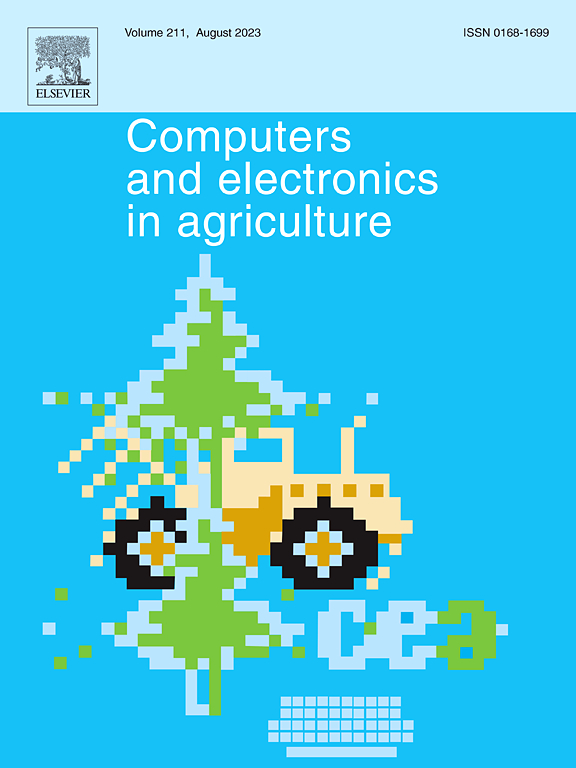柠条低损伤切削机理及操作参数优化试验。基于离散元法的茎
IF 8.9
1区 农林科学
Q1 AGRICULTURE, MULTIDISCIPLINARY
引用次数: 0
摘要
柠条生长过程中各生产参数动态耦合机制不明确。(CK)采收作业导致割茎残茬平整度不理想,损害了CK的多年生再生能力,造成了显著的生物质资源浪费。这就需要对CK茎的低损伤切割力学进行理论探索,以优化收获参数。建立了用圆刀切割茎的数学模型。通过理论分析,确定了刀具的进给速度(Vf)、转速(Rω)和切削角度(θc)是CK切削后影响CK杆截面平整度(qc)的重要因素。数值模拟实验结果表明,随着Vf、Rω和θc的增大,qc表现出“低-高-低”的特性。当这些参数值较小时,阀杆的弯曲角(α)较大,高速颗粒(β)数量较多,阀杆截面出现凸起、凹陷、劈裂等缺陷。同时,杆模型(M)中断裂键数达到较高值,导致qc降低。随着这些参数的增大,刀具切削轨迹变得更加平滑,α和β减小,这些特性减小了刀具对阀杆的扰动和损伤,导致M减小,qc增大。当参数值继续增大时,α、β、M增大,qc减小。采用Box-Behnken设计试验确定了最佳运行参数,当Vf = 3.14 km·h−1,r ω = 995.92 r·min−1,θc = 10.0°时,α和β分别降低1.62% ~ 30.31%和3.85% ~ 37.73%,M降低1.08% ~ 15.10%,qc提高0.40% ~ 17.20%。田间试验验证了数值模拟结果,残茬平整率为91.2%,与数值模拟实验结果相比误差为1.5%。同时,漏割率为7.5%,符合CK采收的农艺要求。这项工作推进了茎-刀相互作用理论,并为高效CK收割机的发展提供了指导。本文章由计算机程序翻译,如有差异,请以英文原文为准。

Low-damage cutting mechanism and optimisation experiments of operating parameters of Caragana korshinskii Kom. Stems based on discrete element method
The unclear dynamic coupling mechanisms among operational parameters during Caragana korshinskii Kom. (CK) harvesting operations lead to suboptimal stubble flatness of cut stems, impairing perennial CK regrowth capacity and causing significant biomass resource waste. This necessitates theoretical exploration of low-damage cutting mechanics for CK stems to optimize harvesting parameters. We established a mathematical model for cutting stems with a circular cutter. Through theoretical analysis, it was determined that the feed speed (Vf), rotational speed (Rω), and cutting angle (θc) of the cutter are important factors affecting the CK stem cross-section flatness (qc) after CK cutting. Numerical simulation experiment results indicated that qc exhibits a ‘low–high-low’ characteristic as Vf, Rω, and θc increase. When the values of these parameters are small, the bending angle of the stem (α) is large, the quantity of high-speed particles (β) is high, the stem cross-section manifests defects including bumps, depressions, and splits. Concurrently, the number of broken bonds in the stem model (M) reached higher values, leading to a reduction in qc. As the values of these parameters increase, the cutter cutting trajectory becomes smoother, α and β decrease, and these characteristics reduce the cutter’s disturbance and damage to the stem, causing M to decrease and qc to increase. When the parameter values continue to increase, α, β, and M increase, and qc decreases. The optimum operating parameters were determined using the Box-Behnken design test, when Vf = 3.14 km·h−1, Rω = 995.92 r·min−1, and θc = 10.0°, α and β decreased by 1.62 %–30.31 % and 3.85 %–37.73 %, M decreased by 1.08 %–15.10 %, and qc increased by 0.40 %–17.20 %. The field experiments verified the results of the numerical simulation, in which the residual stubble levelling was 91.2 %, with an error of 1.5 % compared to the results of numerical simulation experiments. Simultaneously, the missed cutting rate was 7.5 %, which met the agronomic requirements for CK harvesting. This work advances stem-cutter interaction theory and informs high-efficiency CK harvester development.
求助全文
通过发布文献求助,成功后即可免费获取论文全文。
去求助
来源期刊

Computers and Electronics in Agriculture
工程技术-计算机:跨学科应用
CiteScore
15.30
自引率
14.50%
发文量
800
审稿时长
62 days
期刊介绍:
Computers and Electronics in Agriculture provides international coverage of advancements in computer hardware, software, electronic instrumentation, and control systems applied to agricultural challenges. Encompassing agronomy, horticulture, forestry, aquaculture, and animal farming, the journal publishes original papers, reviews, and applications notes. It explores the use of computers and electronics in plant or animal agricultural production, covering topics like agricultural soils, water, pests, controlled environments, and waste. The scope extends to on-farm post-harvest operations and relevant technologies, including artificial intelligence, sensors, machine vision, robotics, networking, and simulation modeling. Its companion journal, Smart Agricultural Technology, continues the focus on smart applications in production agriculture.
 求助内容:
求助内容: 应助结果提醒方式:
应助结果提醒方式:


